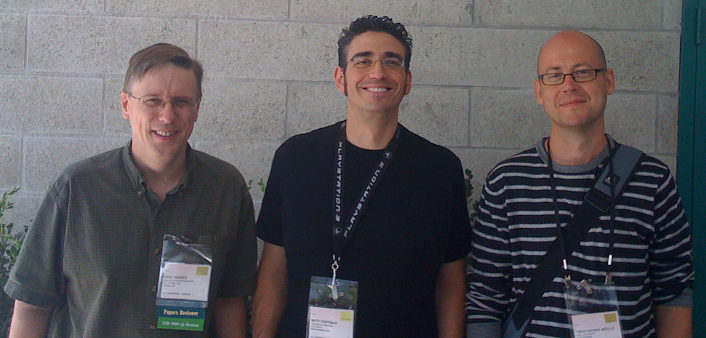The mention of bilateral filters in the last post reminded me – the updated SIGGRAPH 2008 version of the bilateral filtering course slides have recently been put up on the course web page. The course (also discussed in a n older post) is an excellent introduction to this increasingly important topic.
Tag Archives: SIGGRAPH 2008
SIGGRAPH 2008: Bilateral Filters
The class “A Gentle Introduction to Bilateral Filtering and its Applications” was very well-presented. Bilateral filters are edge-preserving smoothing filters that have many applications in rendering and computational photography. The basic concept was clearly explained, and then various variants, related techniques, optimized implementations and applications were discussed. The full slides as well as detailed course notes are available here. Currently they are from the SIGGRAPH 2007 course; I assume the 2008 slides will replace them soon.
A related technique, which appears to have some interesting advantages over the bilateral filter, was presented in a paper this year, titled “Edge-Preserving Decompositions for Multi-Scale Tone and Detail Manipulation”. It presents a novel edge-preserving smoothing operator based on weighted least squares optimization. The paper and various supplementary materials are available here.
SIGGRAPH 2008: Beyond Programmable Shading Class
This class was about non-traditional processing performed on GPUs, similar to GPGPU but for graphics. As we discuss in the “Futures” chapter at the end of our book, this is a particularly interesting direction of research and may well represent the future of rendering. The recent disclosures on Direct3D 11 Compute Shaders and Larrabee make this a particularly hot topic.
The full course notes are available at the course web site.
The talk by Jon Olick from id software was perhaps the most interesting. He discussed a sparse voxel octree data structure which is rendered directly using CUDA. This extends id’s megatexture idea to geometry and may very well find its way into id’s next engine in some form.
SIGGRAPH 2008: The Authors Meet
All the work on the book was done remotely, via email and CVS. In fact, I had never met Tomas until this morning at SIGGRAPH. Here you can see all three of us, pleased as punch that the book is finally done. Left to right, Eric, Naty, Tomas:
(Eric here. I guess this is a tradition: Tomas and I didn’t meet until after the first edition was published.)
SIGGRAPH 2008: Advances in Real-Time Rendering in 3D Graphics and Games
I attended the “Advances in Real-Time Rendering in 3D Graphics and Games” class today at SIGGRAPH. This is the third year in a row Natasha Tatarchuk from AMD has organized this class. Each year different game developers as well as people from the AMD demo team are brought in to talk about graphics, and some of the best real-time stuff at SIGGRAPH in the last two years has been in this course.
Unfortunately, due to Little Big Planet crunch, Alex Evans from Media Molecule was unable to give his planned talk and a different speaker was brought in instead. This was a bit of a bummer since Alex’s SIGGRAPH 2006 talk was very good and I was hoping to hear more about his unorthodox take on real-time rendering.
The remaining talks were of high quality, including talks by the developers of games such as Halo 3, Starcraft 2 and Crysis. Unlike previous years, where it took many weeks for the course notes to be available online, the full course notes are already available at AMD’s Technical Publications page – check them out!
